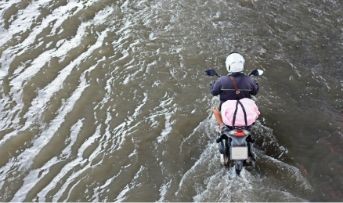Blog Details - Magma HDI

The complete guide for bike safety during floods 4th May 2019
Biking is a well-liked form of exercise and transportation, but it may also be dangerous when floods occur. One of the natural calamities that occur most frequently worldwide is flooding. As a result, the nation suffers severe socio-economic losses. Floodwaters can cause highway disasters, create dangerous situations, and increase the risk of electrocution. You can, however, ride your bike safely during floods if you take the proper safety measures.
Even though caution can significantly lower the chance of accidents and injuries when biking through floods, unexpected events can still occur. Bike insurance offers financial security and peace of mind in such circumstances. Here's a detailed guide to biking safely during floods.
1. Plan your route
It's essential to consider regions prone to flooding, such as low-lying areas, riverbanks, and bridges, while planning your motorcycling route during a flood. Always stay on high ground and avoid these regions. Plan a path that stays clear of the flooded areas using online maps.
2. Use lights
Motorcycle lights make you more visible to other drivers when it's dark or low light. Ensure that your bike has lights and reflectors. It would help if you also considered bringing a tiny torch or headlamp in an emergency.
3. Stay informed
It's essential to be aware of local conditions before riding a bike during a flood. If there are flood warnings or advisories, keep an eye on local weather forecasts and news updates to stay informed. Avoid riding in regions with flood warnings or advisories and take a different route.
4. Wear appropriate gear
You must wear appropriate clothing to protect yourself from the rain and water when riding through a flood. Put on a waterproof jacket and a pair of trousers to keep dry. Ensure that your shoes are water-resistant as well. Wearing reflective clothing or gear can improve your visibility to other drivers.
5. Slow down
Riding in flooded regions requires extra caution and slowing down. Floodwaters may be deeper than they appear and may cover trash or other obstructions. To avoid any unforeseen dangers, slow down.
6. Watch out for dangers
Be cautious when riding through floodwaters to avoid obstacles like downed trees, electricity lines, and perhaps washed-in debris. Avoid these risks whenever possible. If you encounter a downed power line, maintain a distance of at least 10 feet and contact your local power company immediately.
7. Follow the guidance of authorities
It's essential to follow the advice of emergency officials and local authorities during a flood. Road closures and evacuation orders may be included in this. Consult with local authorities first if you are unsure whether riding in a particular location is safe.
8. Stay on marked bike paths
Stick to marked riding paths or roads that are open and safe for commuting. Avoid any areas that are closed off or that the authorities have blocked. When a road is closed, or a diversion is indicated, follow the instructions on the sign.
9. Avoid fast-moving water
Avoid riding your bike across the moving water since it might easily knock you off and take you with it. If you must ride your bike through the water to cross a flooded area, walk your bike instead. Remember that riding a motorcycle through even a few inches of water can be fatal.
Additional safety measures and close attention to detail are needed when biking during a flood. You can safeguard your safety when biking through floods by carefully planning your route and following official guidance. Remember, it's always better to avoid biking in dangerous conditions whenever possible. Bike insurance can offer significant financial protection in unforeseen circumstances like floods or other conditions. Review your policy carefully and take the appropriate safety measures to safeguard you and your bike.
Click HERE to invest in the bike insurance policy.
Disclaimer: The information provided above is for illustrative purposes only. To get more details, please refer to policy wordings and prospectus before purchasing a policy.

